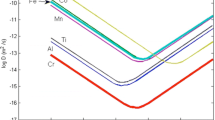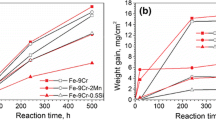Abstract
The oxidation of Fe-Cr-C alloys containing 13% Cr and carbon ranging from 0.15 to 1.63% was studied at 1100°C for 3 hr. It was found that the oxidation rate increased with increasing carbon content in the alloys. The measured time variation of CO2 evolution showed that, during the first period of oxidation (0–40 min), a compact surface layer of FeO formed, which prohibited the free transfer of CO2 into the streaming oxidation atmosphere. The measurable CO2 evolution started between 40 and 50 min, and the most rapid evolution occurred in the interval t=60–90 min of oxidation. This effect corresponds well to scale-layer damage and to the maximum O2 absorption. The measurements carried out by the combined thermobalance-Chromatograph equipment were supplemented by metallographic investigation of the oxide layers. The results enabled us to interpret the primary stage of the oxidation of Fe-Cr-C alloys and to discuss the relations between the cation diffusivities in the individual oxide sublayers, i.e., in wustite, magnetite, and hematite.
Similar content being viewed by others
References
A. U. Malik,Oxid. Met. 25, 233 (1985).
J. Baud, A. Ferrier, J. Manenc, and J. Bénard,Oxid. Met. 9, 69 (1975).
D. Caplan, G. I. Sproule, R. J. Hussey, and M. J. Graham,Oxid. Met. 12, 67 (1978).
D. Caplan, G. I. Sproule, R. J. Hussey, and M. J. Graham,Oxid. Met. 13, 255 (1979).
A. U. Malik and D. P. Whittle,Oxid. Met. 16, 339 (1981).
O. T. Goncel, D. P. Whittle, and J. Stringer,Oxid. Met. 15, 287 (1981).
D. N. H. Trafford and D. P. Whittle,Corros. Sci. 20, 497 (1980).
D. N. H. Trafford and D. P. Whittle,Corros. Sci. 20, 509 (1980).
Y. Ikeda and K. Nii,Oxid. Met. 12, 487 (1978).
C. L. Angerman,Oxid. Met. 5, 149 (1972).
J. Manenc and G. Vagnard,Corros. Sci. 9, 857 (1969).
J. Baud, J. P. Plumensi, and J. Manenc,Werkst. Korros. 23, 866 (1972).
M. Hajduga and J. Kučera,Proceedings of the Sixth Symposium on Metallography, Vysoké Tatry, Czechoslovakia, P. House, ed. ČSVTS, Košice, part 1, 1986), p. 222.
K. Hauffe, Reaktionen in und an Festen Stoffen (Springer-Verlag, Berlin, 1955), p. 421.
G. Neumann and G. M. Neumann,Surface Self-Diffusion of Metals, F. H. Wöhlbier, ed. (Solothurn, Switzerland, 1982), p. 53.
J. Kučera and K. Stránský,Mat. Sci. Eng. 52, 1 (1982).
J. Askill,Tracer Diffusion Data for Metals, Alloys and Simple Oxides (IFI/Plenum, New York, 1970), pp. 78, 79.
M. Hajduga and J. Kučera,Kovové Mater. 24, 666 (1986).
Author information
Authors and Affiliations
Rights and permissions
About this article
Cite this article
Hajduga, M., Kučera, J. Primary stage of Fe-Cr-C alloy oxidation at 1100°C. Oxid Met 29, 121–133 (1988). https://doi.org/10.1007/BF00656352
Received:
Issue Date:
DOI: https://doi.org/10.1007/BF00656352




